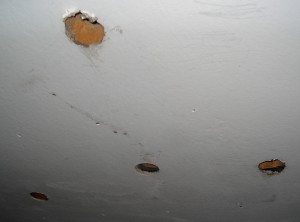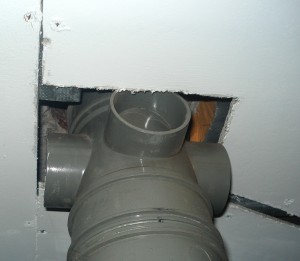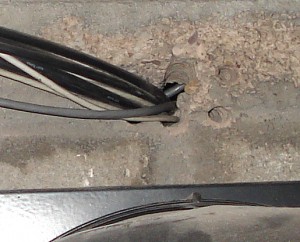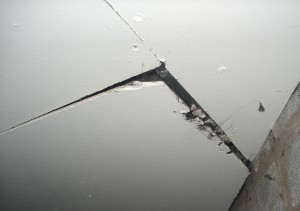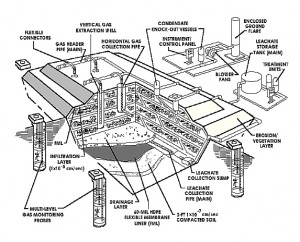2012-03-29: The relentless pressure, within the European Union (EU), to bring a greater measure of stability to imported energy supplies … to reduce our overall use of energy … to be far more efficient in the ways we consume those lesser amounts of energy … to find cleaner sources of energy to replace oil, gas, and especially coal … to comply with ambitious targets on climate change mitigation … are all pointing in one direction with regard to design and construction. We are forced to super-insulate new buildings !
Without many people realizing it, however, we change how fire behaves in a highly insulated building … especially when insulation materials are part of the interior finishes, not carefully buried within the construction. [Even the old Building Bye-Laws in Dublin City permitted a cavity in a masonry wall up to 150mm wide !] And, as usual, Building and Fire Regulations are slow to catch up with these important architectural developments.
Let me show you an example of a basement car park in a new hospital (which shall remain nameless !) … where a serious ‘fire’ problem has been festering since it was opened, and occupied, a few years ago.
This hospital could be anywhere in Europe …
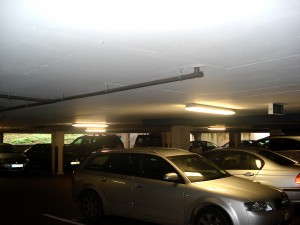
The ceiling height in this car park is low … approximately 2 metres above floor level. The ceiling comprises a 6mm off-white calcium silicate board of limited combustibility (for the techies out there – this board is not ‘incombustible’, and it is not ‘non-combustible’) … above which is a 40mm rigid phenolic thermal insulation board … all fixed to the underside of a concrete floor slab.
This phenolic insulation board is very efficient … and during the normal course of events, its job is to stop the loss of heat from the hospital wards and other areas above. A cold concrete floor is also very uncomfortable for people, i.e. hospital staff, having to walk around on it for long periods.
Because the insulation board is efficient, and it is fixed to the underside of the floor slab … in a fire situation, let’s say that a fire starts in a car … the heat from that fire will be reflected by the insulation board back downwards. The result: the fire will be encouraged to spread much more quickly to neighbouring vehicles. And so, in a very short time, we will have a much larger fire … and a much more intense fire … which will be far more difficult to control and extinguish, when the fire services eventually arrive on the scene.
.
There are a Number of Twists in This Story …
1. For all sorts of normal reasons, there are service penetration openings in the car park ceiling shown above (some small and some large), especially in a hospital which is highly serviced … the overall approach to fire and smoke sealing in this new building is not the best … and workmanship is poor …
… which, together, all mean that it will be easy for fire and smoke to spread upwards into the hospital wards and other areas … in the event of a fire emergency.
In a hospital, not everybody is alert and mobile. It will be difficult to evacuate some people … and it will be nearly impossible, because of their health condition, to evacuate others. In order for a fire engineering strategy of horizontal evacuation to a ‘safer’ part of the same building to be successfully put into effect during an emergency … it is imperative … that the level of passive protection from fire and smoke provided is high … much higher, here, than in the case of an average office building, for example. AND … it is critical … that this high level of protection from fire and smoke is reliable.
In this new hospital building … the photographic evidence clearly shows that both of these criteria have not been met.
.
2. Another twist in the story concerns the rigid phenolic thermal insulation board used in the car park ceiling … which, as the evidence also shows, is exposed to direct view in many places …
In a short, brochure-type document produced by the European Phenolic Foam Association (EPFA): ‘Phenolic Foam Insulation – The Ultimate Insulation System for the Construction & Building Services Industry’, the following is stated with regard to the fire performance of this material …
‘ Toxic gas emission from phenolic foam is generally limited to carbon dioxide and carbon monoxide with very low levels of other gases.’
However, in a report produced by the National Research Council of Canada: ‘Toxicity and Smoke Aspects of Foamed Plastic Insulation – An Annotated Bibliography’ … the following abstracts can be found …
- Toxicity of Off-Gases from Phenolic Rigid Foam
‘ A reference sample of phenolic rigid foam was evaluated for toxicity of off-gases, using various test conditions in the NASA-USF-PSC toxicity screening test method. Test results show that the response of this material to the various test conditions is similar to that exhibited by the majority of other materials previously evaluated by this method. That is, animal response times generally decreased with increasing fixed temperature, and with increasing airflow rate under rising temperature conditions. The authors suggest that formaldehyde is one of the toxicants present although the amount of CO produced at 600°C or higher was enough to be lethal by itself.‘
- Toxicity of Off-Gases from Thermal Insulation
‘ Toxicity test data on the off-gases from various thermal insulation materials are presented in this paper. Under rising temperature without forced airflow test conditions, phenolic foams exhibited the shortest times to death, while polyisocyanurate, polyurethane and polystyrene foams exhibited the longest times to death. The introduction of airflow significantly reduced time to death, apparently due to a higher degree of oxidation and more rapid delivery of toxicants. The authors conclude that under the particular test conditions, plastic thermal insulations appear to exhibit less toxicity than cellulosic board and cellulose insulation, with polyimide and phenolic foams being the exceptions.‘
- Relative Flammability and Toxicity of Thermal Insulation
‘ Relative flammability and relative toxicity data are presented for 30 samples of thermal insulation materials. There appears to be no inherent, necessary compromise between flammability and toxicity in the selection of materials. Cellulosic and plastics insulations appear to represent significantly different combinations of flammability and toxicity hazards, and require different approaches when planning and designing applications. Polyurethane foam appeared to be significantly less toxic and slightly less flammable than wood and other cellulosic materials. Polyisocyanurate foam seemed to be more toxic than polyurethane foam but still less toxic than the cellulosic materials. Polystyrene foam exhibited the longest time to death while phenolic foam showed the second shortest time to death among the group of rigid foams evaluated.‘
- Carbon Monoxide Production from Overheated Thermal Insulation Materials
‘ Carbon monoxide yields were obtained for selected thermal insulation materials. The data are presented and discussed in this paper. Among the rigid foamed plastics, phenolic gave the highest yield of CO under a rising temperature and no airflow test conditions. Polyurethane foams based on propoxylated aromatic amino polyol appeared to produce less CO than polyurethane foams based on propoxylated trimethylolpropane polyol. Under fixed temperatures of 800°C without airflow test conditions, similar results were obtained for the rigid foamed plastics.’
- Toxicity of Pyrolysis Gases from Phenolic and Isocyanurate Rigid Foams
‘ Special reference samples of phenolic and isocyanurate rigid foams were evaluated for toxicity of pyrolysis gases, using 6 different test conditions of the USF toxicity screening test methods. Under rising temperature conditions, phenolic foam appeared to be consistently more toxic than the isocyanurate foam. CO level appears to be the factor, which is twice as high from the phenolic foam. The temperatures corresponding to the times to death indicate that the toxicants were evolved below 500°C for phenolic and below 640°C for isocyanurate. These are in agreement with that of the University of Pittsburgh (UP) data. At a fixed temperature of 800°C, there appeared to be no difference in toxicity between the phenolic and isocyanurate foams, although the former tended to produce more carbon monoxide.’
- Toxicity of Pyrolysis Gases from Phenolic, Isocyanurate and Polystyrene Rigid Foam Insulation
‘ Samples of phenolic, isocyanurate, and polystyrene rigid foam insulation were evaluated for toxicity of pyrolysis gases, using four different test conditions of the toxicity screening test method developed at the University of San Francisco. The test conditions were 200 to 800°C rising temperature and 800°C fixed temperature, each without forced airflow and with 1 L/min airflow. On the average over these four particular test conditions, phenolic foam appeared to exhibit the greatest toxicity and polystyrene foam appeared to exhibit the least toxicity.‘
.
As already discussed in an earlier post , dated 2011-01-13 … we know that Carbon Monoxide (CO) is an odourless, colourless and toxic gas … and because it is impossible to see, taste or smell the toxic fumes, CO can kill before you are aware it is there.
So … it will be easy for Fire, Visible Smoke and Carbon Monoxide to spread upwards into the hospital wards and other areas of this building … in the event of a fire emergency.
.
This Hospital’s ‘Fire’ Problem & Its Solution
The ‘fire’ problem in this hospital has been allowed to fester for a number of years because the issues shown in the photographs above are either inadequately addressed … or not addressed at all … in Ireland’s Technical Guidance Document (TGD) B … a document which is intended merely to present some supporting guidance for operating Part B: ‘Fire Safety’, in the 2nd Schedule of the Building Regulations.
Unfortunately, all parties directly responsible for this hospital debacle are under the very mistaken impression that the guidance in Technical Guidance Document B is prescriptive regulation. This is a major error ! Furthermore … TGD B is fundamentally flawed … and it is particularly inadequate when the building type is a health facility.
To Correct This ‘Fire’ Problem … a Fire Suppression System should immediately be installed in the basement car park. At the same time, if not before … ALL Service Penetration Openings in the concrete floor slab should be properly sealed so that, during a fire incident, the passage of fire and smoke and CO into building spaces above the slab will be prevented. And … the quality of workmanship, on site, must be high !
An appropriate number of Carbon Monoxide Detectors should be installed in the hospital wards and other areas above the concrete floor slab.
.
The ‘Institutional’ Problem
The procedure of having to submit so-called Compliance Reports with applications for Fire Safety Certificates, in Ireland, only confirms … and reinforces … the very mistaken impression in everybody’s minds that the guidance in Technical Guidance Document B is prescriptive regulation.
In the case of a different hospital … let me give you an example of a text contained in one such Compliance Report … submitted to an Irish Local Authority, sometime during 2004 …
Single Steps at Final Exit Doors
It is noted that Clause 1.4.3.4 of TGD-B is ambiguous vis-à-vis steps located on the line of final exit doors, i.e. as opposed to a condition where there is a step beyond the line of a door. Accordingly, it is reasonable and appropriate to make reference to the current England and Wales Approved Document B (2000 Edition) for guidance on this issue in so far as Technical Guidance Document B is based on an early draft of the Approved Document. It is noted that the UK AD-B in Clauses 6.15 and 6.21 specifically allow single steps at final exits provided they are located on the line of the doorway in question. Furthermore, the recently issued Northern Ireland Technical Bulletin E (1994) also allows such steps, subject to the riser not exceeding 180mm. On the basis of the foregoing, single steps are considered acceptable at the final exit doors subject to the riser not exceeding 180mm and the step being located on the line of the door.
This is mindless, incompetent nonsense … and it was accepted by the Local Authority.
How often, anymore, does anybody encounter a step … 180mm high, or of any height … at the front entrance to a new building ? Building designers have finally understood the message that new buildings must be accessible-for-all … and a single step, in any situation, is a trip or a fall accident waiting to happen. Now imagine the situation where people are attempting to evacuate an average office building, for example, during a fire emergency … and they encounter a single step at the final fire exit !?! Now really stretch your imagination … and imagine where people are trying to evacuate a hospital !!??!!
FUBAR !!
The System is not only entirely dysfunctional … it is corrupt !
.
.
END
